Application of Large Language Models in the AECO Industry: Core Technologies, Application Scenarios, and Research Challenges
Abstract
1. Introduction
- (1)
- Review the development status of LLMs in the AECO industry, analyze their core technologies and typical application scenarios, and explore existing technical challenges and industry demands.
- (2)
- Evaluate the practical value of LLMs in AECO, summarizing their advantages in information processing, intelligent decision-making, and project management while providing key technical references for real-world deployment.
- (3)
- Explore the future development of LLMs in AECO, investigating technological innovations, system integration, and interdisciplinary collaborations to provide insights for future research and drive the intelligent transformation of the industry.
2. Materials and Methods
3. LLMs in the AECO Industry: Core Technology, Application Scenarios, and System Integration
3.1. Core Technologies
3.1.1. From Traditional NLP to LLMs
3.1.2. Deep Learning and Machine Learning Technologies
3.2. Application Scenarios of LLMs in AECO Industry
3.2.1. AI-Driven Information and Interaction Systems
- (1)
- Building Information Modeling (BIM)
- (2)
- Expert Systems and Human–Computer Interaction
- (3)
- Knowledge Sharing and Educational Integration
- (4)
- Data and Corpus Development
3.2.2. Engineering Management and Construction Optimization
- (5)
- Contract Management
- (6)
- Construction Scheduling and Task Optimization
- (7)
- Construction Safety Management
- (8)
- Risk Management
3.2.3. Operations and Sustainability
- (9)
- Energy Management
- (10)
- Material Innovation
- (11)
- Geotechnical Engineering
- (12)
- Operations and Maintenance
3.3. Data and Information Processing
3.3.1. Data Collection and Preprocessing
3.3.2. Information Extraction and Knowledge Graph Construction
3.4. Core Components and Key Technologies of the Toolchain
4. Existing Challenges
4.1. Data Layer
4.1.1. Data Quality and Corpus Construction
4.1.2. Data Heterogeneity and Interoperability Issues
4.2. Technical Layer
4.2.1. Collaborative Limitations in Technology Integration
4.2.2. Real-Time and Accuracy Issues in AI Interaction
4.3. Application Layer
4.3.1. Task Specificity: Weak Generalization Ability in Complex Scenarios
4.3.2. Multi-Role Collaboration: Conflicting Interests Leading to Information Bias
4.3.3. Economic Constraints: High Computational Resources and Maintenance Costs
4.3.4. Human–Machine Trust Gap: Trust and Ethical Risks
5. Future Development Directions
5.1. Data Layer Innovations
5.1.1. High-Quality Data Construction and Multilingual Adaptation
5.1.2. Data Enhancement and Multimodal Integration
5.2. Technical Layer Advancements
5.2.1. Technology Integration and System Expansion
5.2.2. Algorithm and Model Optimization
5.3. Application Layer Expansion
5.3.1. User Participation and Scenario Adaptability
5.3.2. Economic Challenges and Efficiency Optimization
5.3.3. Ethics and Explainability
6. Conclusions
Author Contributions
Funding
Data Availability Statement
Conflicts of Interest
References
- Engineers, B. Bim Handbook: A Guide to Building Information Modeling for Owners Managers; Wiley: Hoboken, NJ, USA, 2018. [Google Scholar]
- Succar, B. Building information modelling framework: A research and delivery foundation for industry stakeholders. Autom. Constr. 2009, 18, 357–375. [Google Scholar] [CrossRef]
- Wu, C.; Li, X.; Guo, Y.; Wang, J.; Ren, Z.; Wang, M.; Yang, Z. Natural language processing for smart construction: Current status and future directions. Autom. Constr. 2022, 134, 104059. [Google Scholar] [CrossRef]
- Nasar, Z.; Jaffry, S.W.; Malik, M.K. Named entity recognition and relation extraction: State-of-the-art. ACM Comput. Surv. (CSUR) 2021, 54, 1–39. [Google Scholar] [CrossRef]
- Brown, T.; Mann, B.; Ryder, N.; Subbiah, M.; Kaplan, J.D.; Dhariwal, P.; Neelakantan, A.; Shyam, P.; Sastry, G.; Askell, A. Language models are few-shot learners. Adv. Neural Inf. Process. Syst. 2020, 33, 1877–1901. [Google Scholar]
- Hadi, M.U.; Qureshi, R.; Shah, A.; Irfan, M.; Zafar, A.; Shaikh, M.B.; Akhtar, N.; Wu, J.; Mirjalili, S. Large language models: A comprehensive survey of its applications, challenges, limitations, and future prospects. Authorea Prepr. 2023, 1, 1–26. [Google Scholar]
- Wang, Z.; Li, Y.; Zhu, Z. BERT-based knowledge extraction method of unstructured domain text. arXiv 2021, arXiv:2103.00728. [Google Scholar]
- Jiang, C.; Zheng, Z.; Liang, X.; Lin, J.; Ma, Z.; Lu, X. A new interaction paradigm for building design driven by large language model: Proof of concept with Rhino7. J. Graph. 2024, 45, 594. [Google Scholar]
- Zhao, W.X.; Zhou, K.; Li, J.; Tang, T.; Wang, X.; Hou, Y.; Min, Y.; Zhang, B.; Zhang, J.; Dong, Z. A survey of large language models. arXiv 2023, arXiv:2303.18223. [Google Scholar]
- Chang, Y.; Wang, X.; Wang, J.; Wu, Y.; Yang, L.; Zhu, K.; Chen, H.; Yi, X.; Wang, C.; Wang, Y. A survey on evaluation of large language models. ACM Trans. Intell. Syst. Technol. 2024, 15, 1–45. [Google Scholar] [CrossRef]
- Shamshiri, A.; Ryu, K.R.; Park, J.Y. Text mining and natural language processing in construction. Autom. Constr. 2024, 158, 105200. [Google Scholar] [CrossRef]
- Machi, L.A.; McEvoy, B.T. The Literature Review: Six Steps to Success; SAGE Publications: Thousand Oaks, CA, USA, 2009. [Google Scholar]
- Onatayo, D.; Onososen, A.; Oyediran, A.O.; Oyediran, H.; Arowoiya, V.; Onatayo, E. Generative AI Applications in Architecture, Engineering, and Construction: Trends, Implications for Practice, Education & Imperatives for Upskilling—A Review. Architecture 2024, 4, 877–902. [Google Scholar] [CrossRef]
- Onatayo, D.A.; Srinivasan, R.S.; Shah, B. Ultraviolet Radiation Transmission in Buildings’ Fenestration: Part I, Detection Methods and Approaches Using Spectrophotometer and Radiometer. Buildings 2023, 13, 1670. [Google Scholar] [CrossRef]
- Raiaan, M.A.K.; Mukta, M.S.H.; Fatema, K.; Fahad, N.M.; Sakib, S.; Mim, M.M.J.; Ahmad, J.; Ali, M.E.; Azam, S. A Review on Large Language Models: Architectures, Applications, Taxonomies, Open Issues and Challenges. IEEE Access 2024, 12, 26839–26874. [Google Scholar] [CrossRef]
- Jafari, P.; Al Hattab, M.; Mohamed, E.; AbouRizk, S. Automated extraction and time-cost prediction of contractual reporting requirements in construction using natural language processing and simulation. Appl. Sci. 2021, 11, 6188. [Google Scholar] [CrossRef]
- Raschka, S. Build a Large Language Model (From Scratch); Simon and Schuster: New York, NY, USA, 2024. [Google Scholar]
- Soori, M.; Jough, F.K.G.; Dastres, R.; Arezoo, B. AI-based decision support systems in Industry 4.0, A review. J. Econ. Technol. 2024; in press. [Google Scholar]
- Taye, M.M. Understanding of machine learning with deep learning: Architectures, workflow, applications and future directions. Computers 2023, 12, 91. [Google Scholar] [CrossRef]
- Najafabadi, M.M.; Villanustre, F.; Khoshgoftaar, T.M.; Seliya, N.; Wald, R.; Muharemagic, E. Deep learning applications and challenges in big data analytics. J. Big Data 2015, 2, 1. [Google Scholar] [CrossRef]
- Mohy, A.A.; Bassioni, H.A.; Elgendi, E.O.; Hassan, T.M. Innovations in safety management for construction sites: The role of deep learning and computer vision techniques. Constr. Innov. 2024; ahead of print. [Google Scholar]
- Bonyani, M.; Soleymani, M. Towards improving workers’ safety and progress monitoring of construction sites through construction site understanding. arXiv 2022, arXiv:2210.15760. [Google Scholar]
- Akinosho, T.D.; Oyedele, L.O.; Bilal, M.; Ajayi, A.O.; Delgado, M.D.; Akinade, O.O.; Ahmed, A.A. Deep learning in the construction industry: A review of present status and future innovations. J. Build. Eng. 2020, 32, 101827. [Google Scholar] [CrossRef]
- Chai, P.; Hou, L.; Zhang, G.; Tushar, Q.; Zou, Y. Generative adversarial networks in construction applications. Autom. Constr. 2024, 159, 105265. [Google Scholar] [CrossRef]
- Regenwetter, L.; Nobari, A.H.; Ahmed, F. Deep generative models in engineering design: A review. J. Mech. Des. 2022, 144, 071704. [Google Scholar] [CrossRef]
- Lee, D.; Lee, S.; Masoud, N.; Krishnan, M.; Li, V.C. Digital twin-driven deep reinforcement learning for adaptive task allocation in robotic construction. Adv. Eng. Inform. 2022, 53, 101710. [Google Scholar] [CrossRef]
- Jia, Y.; Wang, J.; Shou, W.; Hosseini, M.R.; Bai, Y. Graph neural networks for construction applications. Autom. Constr. 2023, 154, 104984. [Google Scholar] [CrossRef]
- Chen, G.; Hou, J.; Liu, C.; Hu, K.; Wang, J. Visualization analysis of cross research between big data and construction industry based on knowledge graph. Buildings 2022, 12, 1812. [Google Scholar] [CrossRef]
- Zheng, J.; Fischer, M. Dynamic prompt-based virtual assistant framework for BIM information search. Autom. Constr. 2023, 155, 105067. [Google Scholar] [CrossRef]
- Fernandes, D.; Garg, S.; Nikkel, M.; Guven, G. A GPT-Powered Assistant for Real-Time Interaction with Building Information Models. Buildings 2024, 14, 2499. [Google Scholar] [CrossRef]
- Chen, N.; Lin, X.; Jiang, H.; An, Y. Automated Building Information Modeling Compliance Check through a Large Language Model Combined with Deep Learning and Ontology. Buildings 2024, 14, 1983. [Google Scholar] [CrossRef]
- Dortheimer, J.; Martelaro, N.; Sprecher, A.; Schubert, G. Evaluating large-language-model chatbots to engage communities in large-scale design projects. Artif. Intell. Eng. Des. Anal. Manuf. 2024, 38, e4. [Google Scholar] [CrossRef]
- Forth, K.; Borrmann, A. Semantic enrichment for BIM-based building energy performance simulations using semantic textual similarity and fine-tuning multilingual LLM. J. Build. Eng. 2024, 95, 110312. [Google Scholar] [CrossRef]
- Kang, T.; Kang, K. Earthwork Network Architecture (ENA): Research for Earthwork Quantity Estimation Method Improvement with Large Language Model. Appl. Sci. 2024, 14, 10517. [Google Scholar] [CrossRef]
- Al-Turki, D.; Hettiarachchi, H.; Gaber, M.M.; Abdelsamea, M.M.; Basurra, S.; Iranmanesh, S.; Saadany, H.; Vakaj, E. Human-in-the-Loop Learning with LLMs for Efficient RASE Tagging in Building Compliance Regulations. IEEE Access 2024, 12, 185291–185306. [Google Scholar] [CrossRef]
- Zhong, Y.; Goodfellow, S.D. Domain-specific language models pre-trained on construction management systems corpora. Autom. Constr. 2024, 160, 105316. [Google Scholar] [CrossRef]
- Zheng, Z.; Lu, X.-Z.; Chen, K.-Y.; Zhou, Y.-C.; Lin, J.-R. Pretrained domain-specific language model for general information retrieval tasks in the AEC domain. arXiv 2022, arXiv:2203.04729. [Google Scholar]
- Gao, B.; Hu, Y.; Gu, J.; Han, X. Integrating deep learning and multi-attention for joint extraction of entities and relationships in engineering consulting texts. Autom. Constr. 2024, 168, 105739. [Google Scholar] [CrossRef]
- Li, H.; Yang, R.; Xu, S.; Xiao, Y.; Zhao, H. Intelligent Checking Method for Construction Schemes via Fusion of Knowledge Graph and Large Language Models. Buildings 2024, 14, 2502. [Google Scholar] [CrossRef]
- Lee, J.; Jung, W.; Baek, S. In-House Knowledge Management Using a Large Language Model: Focusing on Technical Specification Documents Review. Appl. Sci. 2024, 14, 2096. [Google Scholar] [CrossRef]
- Kim, D.; Kim, T.; Kim, Y.; Byun, Y.-H.; Yun, T.S. A ChatGPT-MATLAB framework for numerical modeling in geotechnical engineering applications. Comput. Geotech. 2024, 169, 106237. [Google Scholar] [CrossRef]
- Kumar, K. Geotechnical parrot tales (gpt): Harnessing large language models in geotechnical engineering. J. Geotech. Geoenvironmental Eng. 2024, 150, 02523001. [Google Scholar] [CrossRef]
- Tian, S.; Jiang, X.; Wang, W.; Jing, Z.; Zhang, C.; Zhang, C.; Lookman, T.; Su, Y. Steel design based on a large language model. Acta Mater. 2025, 285, 120663. [Google Scholar] [CrossRef]
- He, C.; Yu, B.; Liu, M.; Guo, L.; Tian, L.; Huang, J. Utilizing Large Language Models to Illustrate Constraints for Construction Planning. Buildings 2024, 14, 2511. [Google Scholar] [CrossRef]
- Chen, G.; Alsharef, A.; Ovid, A.; Albert, A.; Jaselskis, E. Meet2Mitigate: An LLM-powered framework for real-time issue identification and mitigation from construction meeting discourse. Adv. Eng. Inform. 2025, 64, 103068. [Google Scholar] [CrossRef]
- Bah Esseme, A.; Faniyan, A.; Farayola, G. AI in Project Management: Enhancing Efficiency. Decis. Mak. Risk Manag. J. Artif. Intell. Mach. Learn. Data Sci. 2025, 3, 2107–2114. [Google Scholar]
- Prieto, S.A.; Mengiste, E.T.; García de Soto, B. Investigating the Use of ChatGPT for the Scheduling of Construction Projects. Buildings 2023, 13, 857. [Google Scholar] [CrossRef]
- Shishehgarkhaneh, M.B.; Moehler, R.C.; Fang, Y.; Hijazi, A.A.; Aboutorab, H. Transformer-Based Named Entity Recognition in Construction Supply Chain Risk Management in Australia. IEEE Access 2024, 12, 41829–41851. [Google Scholar] [CrossRef]
- Zhang, L.; Wang, J.; Wang, Y.; Sun, H.; Zhao, X. Automatic construction site hazard identification integrating construction scene graphs with BERT based domain knowledge. Autom. Constr. 2022, 142, 104535. [Google Scholar] [CrossRef]
- Lee, W.; Lee, S. Development of a Knowledge Base for Construction Risk Assessments Using BERT and Graph Models. Buildings 2024, 14, 3359. [Google Scholar] [CrossRef]
- Zhou, H.; Tang, S.; Huang, W.; Zhao, X. Generating risk response measures for subway construction by fusion of knowledge and deep learning. Autom. Constr. 2023, 152, 104951. [Google Scholar] [CrossRef]
- Cao, K.; Chen, S.; Yang, C.; Li, Z.; Luo, L.; Ren, Z. Revealing the coupled evolution process of construction risks in mega hydropower engineering through textual semantics. Adv. Eng. Inform. 2024, 62, 102713. [Google Scholar] [CrossRef]
- Nyqvist, R.; Peltokorpi, A.; Seppänen, O. Can ChatGPT exceed humans in construction project risk management? Eng. Constr. Archit. Manag. 2024, 31, 223–243. [Google Scholar] [CrossRef]
- Zhong, B.; Shen, L.; Pan, X.; Lei, L. Visual attention framework for identifying semantic information from construction monitoring video. Saf. Sci. 2023, 163, 106122. [Google Scholar] [CrossRef]
- Shin, S.-H.; Won, J.-H.; Jeong, H.-J.; Kang, M.-G. Development of a Site Information Classification Model and a Similar-Site Accident Retrieval Model for Construction Using the KLUE-BERT Model. Buildings 2024, 14, 1797. [Google Scholar] [CrossRef]
- Tian, D.; Li, M.; Ren, Q.; Zhang, X.; Han, S.; Shen, Y. Intelligent question answering method for construction safety hazard knowledge based on deep semantic mining. Autom. Constr. 2023, 145, 104670. [Google Scholar] [CrossRef]
- Liu, X.; Jing, X.; Zhu, Q.; Du, W.; Wang, X. Automatic construction hazard Identification integrating on-site scene graphs with information extraction in outfield test. Buildings 2023, 13, 377. [Google Scholar] [CrossRef]
- Smetana, M.; Salles de Salles, L.; Sukharev, I.; Khazanovich, L. Highway Construction Safety Analysis Using Large Language Models. Appl. Sci. 2024, 14, 1352. [Google Scholar] [CrossRef]
- Uhm, M.; Kim, J.; Ahn, S.; Jeong, H.; Kim, H. Effectiveness of retrieval augmented generation-based large language models for generating construction safety information. Autom. Constr. 2025, 170, 105926. [Google Scholar] [CrossRef]
- Yoo, B.; Kim, J.; Park, S.; Ahn, C.R.; Oh, T. Harnessing Generative Pre-Trained Transformers for Construction Accident Prediction with Saliency Visualization. Appl. Sci. 2024, 14, 664. [Google Scholar] [CrossRef]
- Lee, J.; Ahn, S.; Kim, D.; Kim, D. Performance comparison of retrieval-augmented generation and fine-tuned large language models for construction safety management knowledge retrieval. Autom. Constr. 2024, 168, 105846. [Google Scholar] [CrossRef]
- Park, S.; Menassa, C.C.; Kamat, V.R. Integrating large language models with multimodal virtual reality interfaces to support collaborative human–robot construction work. J. Comput. Civ. Eng. 2025, 39, 04024053. [Google Scholar] [CrossRef]
- You, H.; Ye, Y.; Zhou, T.; Zhu, Q.; Du, J. Robot-Enabled Construction Assembly with Automated Sequence Planning Based on ChatGPT: RoboGPT. Buildings 2023, 13, 1772. [Google Scholar] [CrossRef]
- Pu, H.; Yang, X.; Li, J.; Guo, R. AutoRepo: A general framework for multimodal LLM-based automated construction reporting. Expert Syst. Appl. 2024, 255, 124601. [Google Scholar] [CrossRef]
- Luo, H.; Wu, J.; Liu, J.; Antwi-Afari, M.F. Large language model-based code generation for the control of construction assembly robots: A hierarchical generation approach. Dev. Built Environ. 2024, 19, 100488. [Google Scholar] [CrossRef]
- Zhang, C.; Lei, X.; Xia, Y.; Sun, L. Automatic bridge inspection database construction through hybrid information extraction and large language models. Dev. Built Environ. 2024, 20, 100549. [Google Scholar] [CrossRef]
- Shooshtarian, S.; Gurmu, A.T.; Sadick, A.-M. Application of natural language processing in residential building defects analysis: Australian stakeholders’ perceptions, causes and types. Eng. Appl. Artif. Intell. 2023, 126, 107178. [Google Scholar] [CrossRef]
- Liu, M.; Zhang, L.; Chen, J.; Chen, W.-A.; Yang, Z.; Lo, L.J.; Wen, J.; O’Neill, Z. Large language models for building energy applications: Opportunities and challenges. Build. Simul. 2025, 18, 225–234. [Google Scholar] [CrossRef]
- Xu, F.; Nguyen, T.; Du, J. Augmented Reality for Maintenance Tasks with ChatGPT for Automated Text-to-Action. J. Constr. Eng. Manag. 2024, 150, 04024015. [Google Scholar] [CrossRef]
- Yu, Z.; Fung, B.C.; Haghighat, F. Extracting knowledge from building-related data—A data mining framework. In Proceedings of the Building Simulation, Chambery, France, 25–28 August 2013; pp. 207–222. [Google Scholar]
- Moon, S.; Chi, S.; Im, S.-B. Automated detection of contractual risk clauses from construction specifications using bidirectional encoder representations from transformers (BERT). Autom. Constr. 2022, 142, 104465. [Google Scholar] [CrossRef]
- Wong, S.; Zheng, C.; Su, X.; Tang, Y. Construction contract risk identification based on knowledge-augmented language models. Comput. Ind. 2024, 157–158, 104082. [Google Scholar] [CrossRef]
- Kazemi, M.H.; Alvanchi, A. Application of NLP-based models in automated detection of risky contract statements written in complex script system. Expert Syst. Appl. 2025, 259, 125296. [Google Scholar] [CrossRef]
- Pan, Z.; Su, C.; Deng, Y.; Cheng, J. Image2Triplets: A computer vision-based explicit relationship extraction framework for updating construction activity knowledge graphs. Comput. Ind. 2022, 137, 103610. [Google Scholar] [CrossRef]
- Saka, A.; Taiwo, R.; Saka, N.; Salami, B.A.; Ajayi, S.; Akande, K.; Kazemi, H. GPT models in construction industry: Opportunities, limitations, and a use case validation. Dev. Built Environ. 2024, 17, 100300. [Google Scholar] [CrossRef]
- Rane, N.; Choudhary, S.; Rane, J. Integrating ChatGPT, Bard, and Leading-Edge Generative Artificial Intelligence in Building and Construction Industry: Applications, Framework, Challenges, and Future Scope. 2023. Available online: https://papers.ssrn.com/sol3/papers.cfm?abstract_id=4645597 (accessed on 16 April 2025).
- Ghimire, P.; Kim, K.; Acharya, M. Opportunities and Challenges of Generative AI in Construction Industry: Focusing on Adoption of Text-Based Models. Buildings 2024, 14, 220. [Google Scholar] [CrossRef]
- Taiwo, R.; Bello, I.T.; Abdulai, S.F.; Yussif, A.-M.; Salami, B.A.; Saka, A.; Seghier, M.E.A.B.; Zayed, T. Generative artificial intelligence in construction: A Delphi approach, framework, and case study. Alex. Eng. J. 2025, 116, 672–698. [Google Scholar] [CrossRef]
- Lin, T.-H.; Huang, Y.-H.; Putranto, A. Intelligent question and answer system for building information modeling and artificial intelligence of things based on the bidirectional encoder representations from transformers model. Autom. Constr. 2022, 142, 104483. [Google Scholar] [CrossRef]
- Lin, J.R.; Hu, Z.Z.; Zhang, J.P.; Yu, F.Q. A natural-language-based approach to intelligent data retrieval and representation for cloud BIM. Comput.-Aided Civ. Infrastruct. Eng. 2016, 31, 18–33. [Google Scholar] [CrossRef]
- Maalek, R. Integrating Generative Artificial Intelligence and Problem-Based Learning into the Digitization in Construction Curriculum. Buildings 2024, 14, 3642. [Google Scholar] [CrossRef]
- Ngo, T.T.A.; An, G.K.; Nguyen, P.T.; Tran, T.T. Unlocking educational potential: Exploring students’ satisfaction and sustainable engagement with ChatGPT using the ECM model. J. Inf. Technol. Educ. Res. 2024, 23, 021. [Google Scholar]
- Jeong, J.; Gil, D.; Kim, D.; Jeong, J. Current Research and Future Directions for Off-Site Construction through LangChain with a Large Language Model. Buildings 2024, 14, 2374. [Google Scholar] [CrossRef]
- Yang, Y.; Wu, Z.; Yang, Y.; Lian, S.; Guo, F.; Wang, Z. A Survey of Information Extraction Based on Deep Learning. Appl. Sci. 2022, 12, 9691. [Google Scholar] [CrossRef]
- Pu, H.; Chen, W. Review of multimodal named entity recognition studies. Data Anal. Knowl. Discov. 2024, 8, 50–63. [Google Scholar]
- Swarup, A.; Bhandarkar, A.; Dizon-Paradis, O.P.; Wilson, R.; Woodard, D.L. Maximizing Relation Extraction Potential: A Data-Centric Study to Unveil Challenges and Opportunities. IEEE Access 2024, 12, 167655–167682. [Google Scholar] [CrossRef]
- Tang, J.; Song, S.; Du, Q.; Yao, Y.; Qu, J. Graph convolutional networks with the self-attention mechanism for adaptive influence maximization in social networks. Complex Intell. Syst. 2024, 10, 8383–8401. [Google Scholar] [CrossRef]
- Guo, Z.; Zhang, Y.; Lu, W. Attention guided graph convolutional networks for relation extraction. arXiv 2019, arXiv:1906.07510. [Google Scholar]
- Mirza, P.; Tonelli, S. Catena: Causal and temporal relation extraction from natural language texts. In Proceedings of the 26th International Conference on Computational Linguistics, Osaka, Japan, 11–16 December 2016; pp. 64–75. [Google Scholar]
- Piskorski, J.; Yangarber, R. Information extraction: Past, present and future. In Multi-Source, Multilingual Information Extraction and Summarization; Springer: Berlin/Heidelberg, Germany, 2013; pp. 23–49. [Google Scholar]
- Choi, S.; Jung, Y. Knowledge Graph Construction: Extraction, Learning, and Evaluation. Appl. Sci. 2025, 15, 3727. [Google Scholar] [CrossRef]
- Walker, A. Project Management in Construction; John Wiley & Sons: Hoboken, NJ, USA, 2015. [Google Scholar]
- Akbarpour, M. Network Theory in Engineering Project Management: A Review of Graph-Based Models for Optimization. Manag. Strateg. Eng. Sci. 2023, 5, 32–41. [Google Scholar]
- Venugopal, M.; Eastman, C.M.; Sacks, R.; Teizer, J. Semantics of model views for information exchanges using the industry foundation class schema. Adv. Eng. Inform. 2012, 26, 411–428. [Google Scholar] [CrossRef]
- Paskoff, C.; Boton, C.; Blanchet, P. Comparative analyses of four BIM-based compliance checking tools. In Proceedings of the Canadian Society of Civil Engineering Annual Conference, Moncton, NB, Canada, 24–27 May 2023; pp. 461–471. [Google Scholar]
- ISO 19650-1: 2018; BSI Standards Publication Organization and Digitization of Information About Buildings and Civil Engineering Works, Including Building Information Modelling (BIM)-Information Management Using Building Information Modelling. ISO: Geneva, Switzerland, 2018.
- Gao, Y.; Xiong, Y.; Gao, X.; Jia, K.; Pan, J.; Bi, Y.; Dai, Y.; Sun, J.; Wang, H.; Wang, H. Retrieval-augmented generation for large language models: A survey. arXiv 2023, arXiv:2312.10997. [Google Scholar]
- Oh, T.K.; Kwon, Y.J.; Oh, B.-H.; Gwon, Y.-I.; Yoon, H.-K. Suggestions for safety coordinator’s roles at each construction stage (client, designer, supervisor, and contractor) to improve safety and health activities in South Korea. Saf. Sci. 2021, 133, 104994. [Google Scholar]
- Guidotti, R.; Monreale, A.; Ruggieri, S.; Turini, F.; Giannotti, F.; Pedreschi, D. A survey of methods for explaining black box models. ACM Comput. Surv. (CSUR) 2018, 51, 1–42. [Google Scholar] [CrossRef]
- Wu, B.; Liu, S.; Zhong, Y.; Sun, P.; Liu, X.; Jin, X. LoongServe: Efficiently Serving Long-Context Large Language Models with Elastic Sequence Parallelism. In Proceedings of the ACM SIGOPS 30th Symposium on Operating Systems Principles, Austin, TX, USA, 4–6 November 2024; pp. 640–654. [Google Scholar]
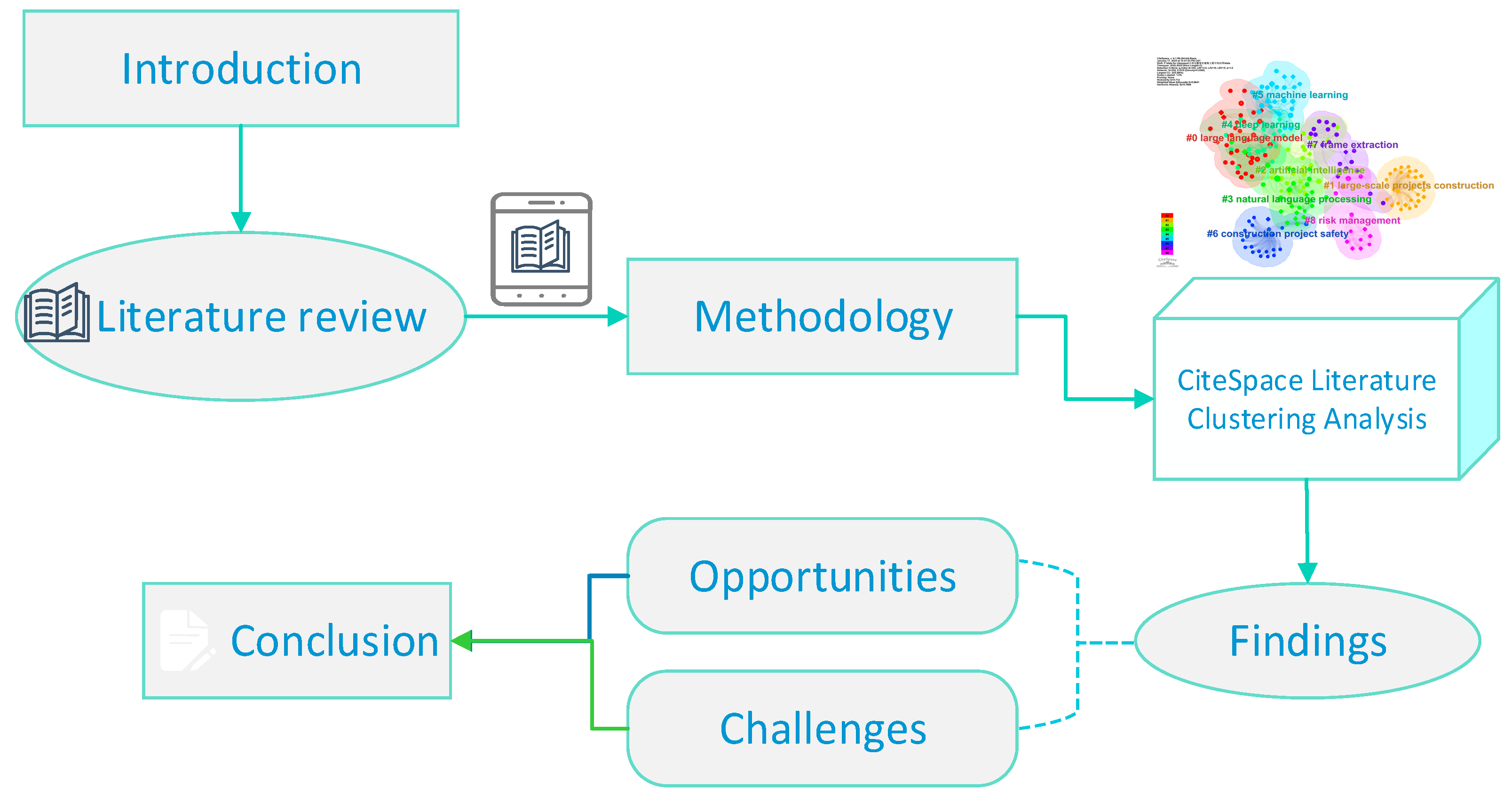
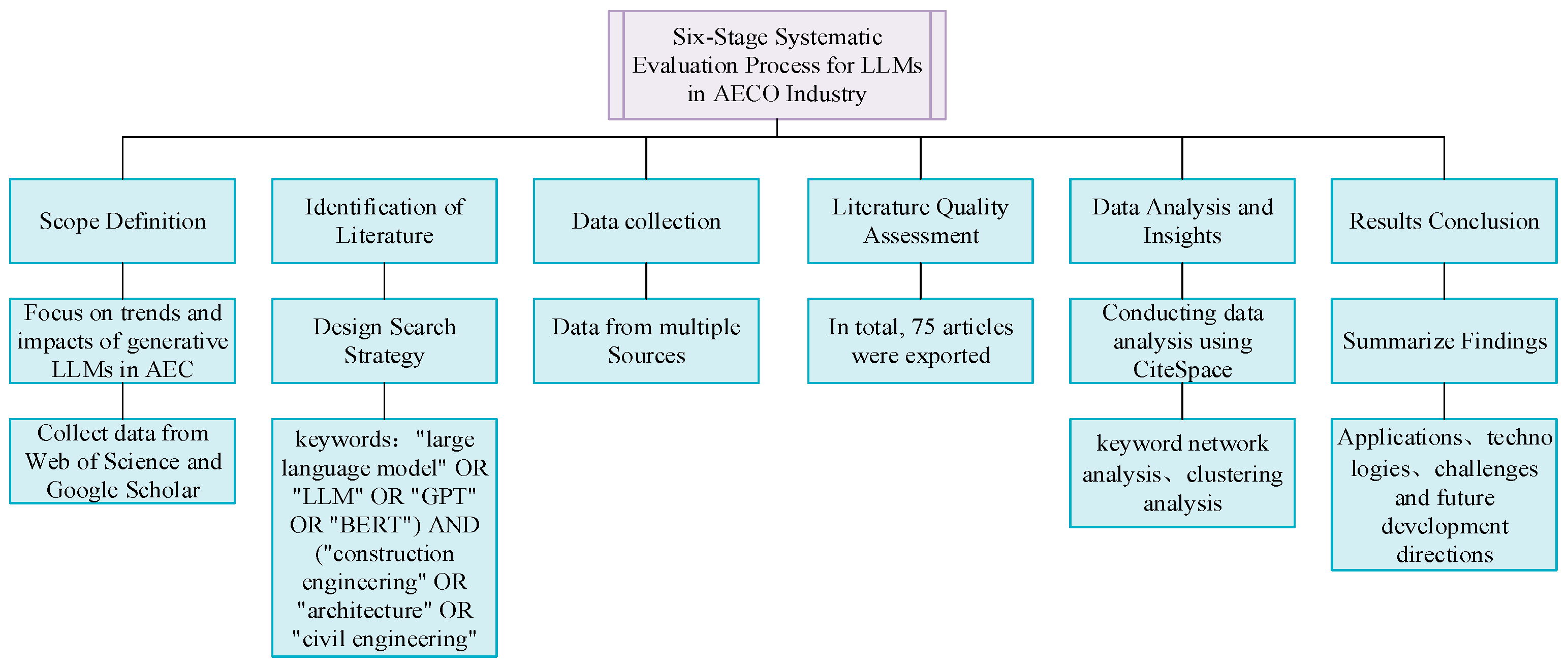
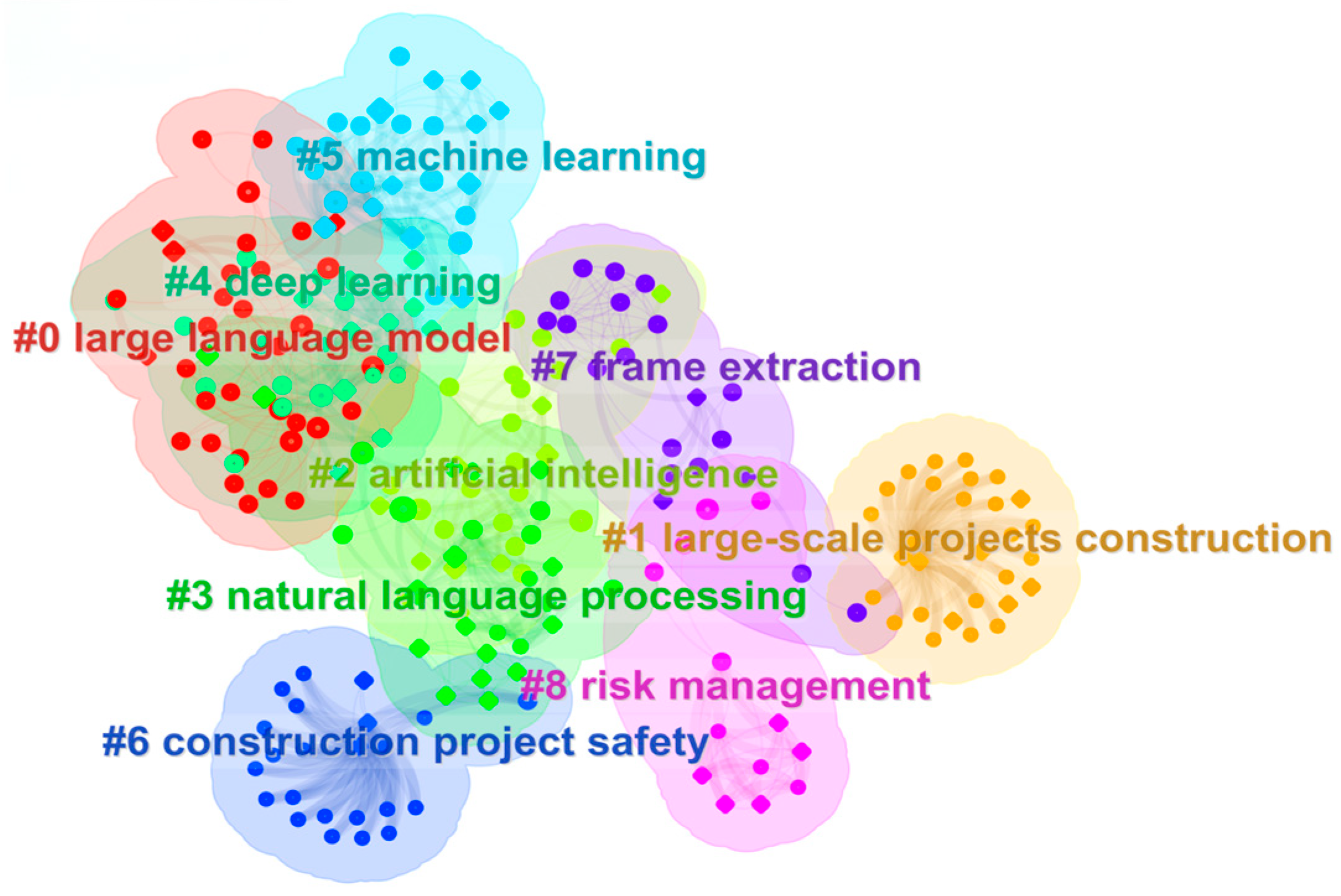
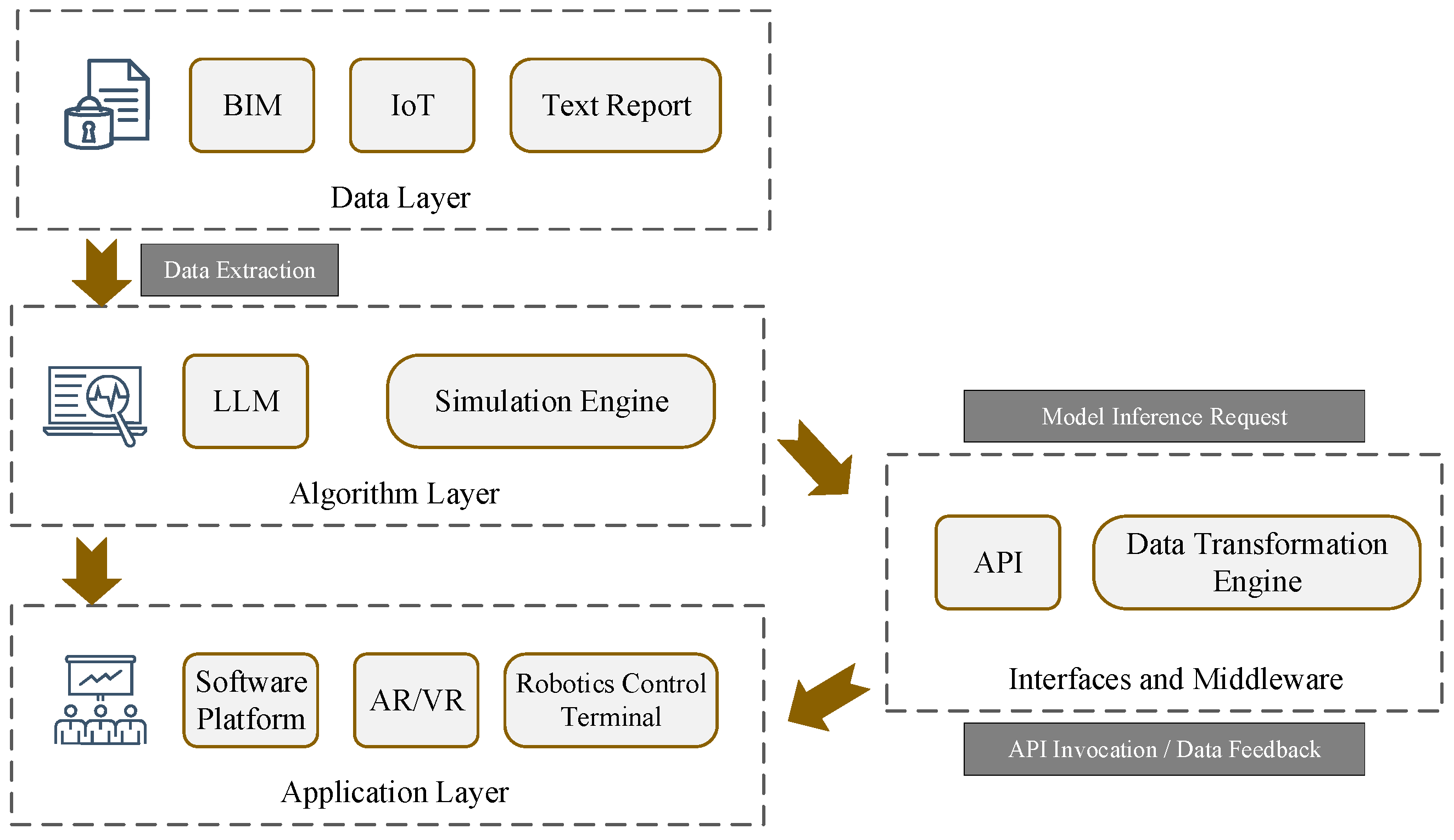
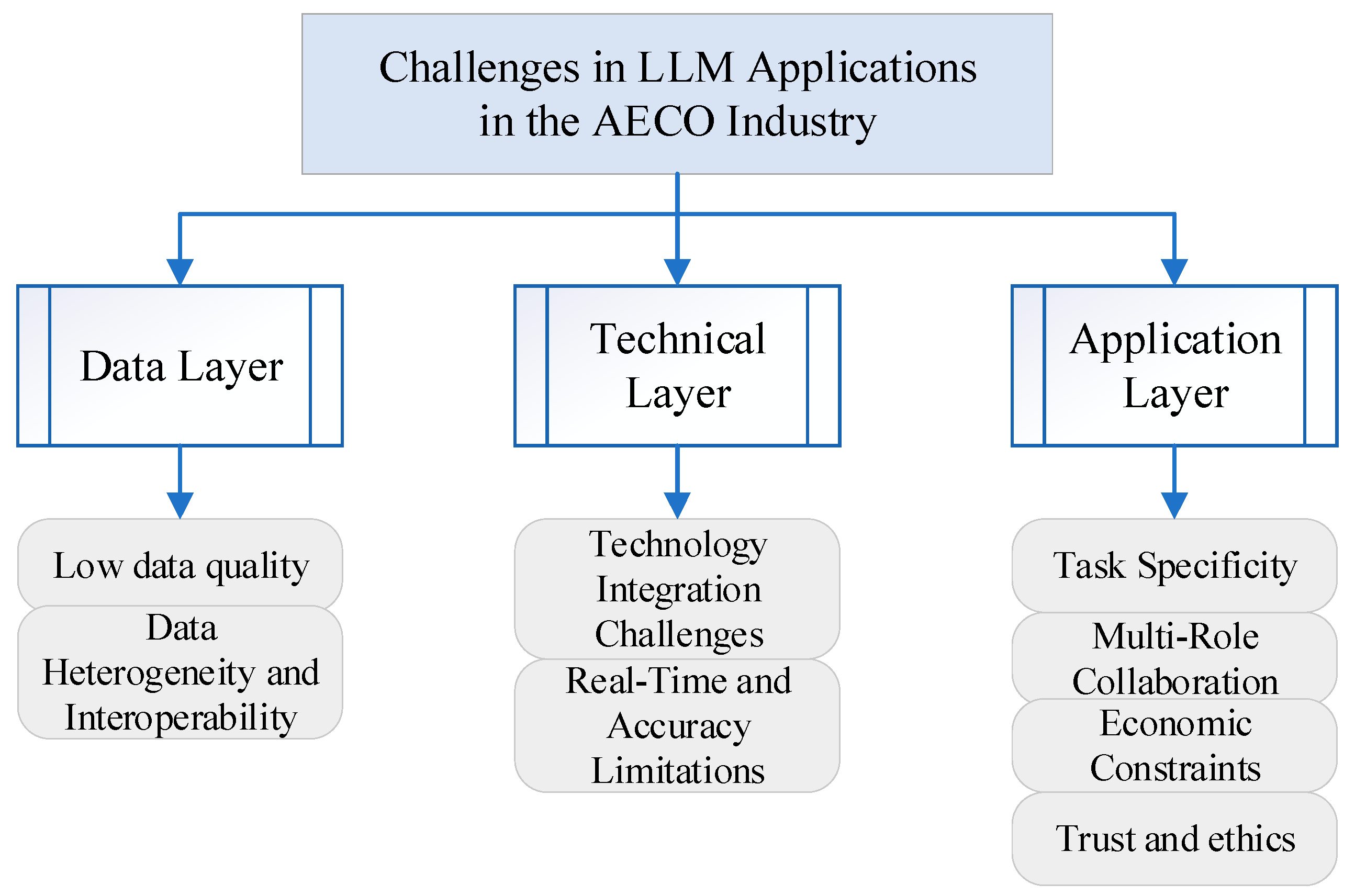
| No. | AECO Phase | Applications | Core Technologies | Papers |
|---|---|---|---|---|
| 1 | A—Architecture | Design Assistance and Optimization | Prompt engineering; generative design; natural language interfaces | [8,29,30,31,32,33] |
| Cost Estimation of Civil Engineering Works | Domain-specific fine-tuning; information extraction | [34] | ||
| Information Retrieval and Integration | Semantic search; knowledge embedding; retrieval-augmented generation | [11,35,36,37,38,39,40] | ||
| 2 | E—Engineering | Geotechnical Engineering | Multimodal input (text + code); technical document parsing | [41,42] |
| Structural Engineering | LLM-to-code generation; parameterized prompting | [43] | ||
| 3 | C—Construction | Construction Management and Optimization | Scheduling LLMs; dialogue-based assistants; task planning | [44,45,46,47] |
| Risk Management | Knowledge graph integration; temporal and causal reasoning | [48,49,50,51,52,53] | ||
| Safety Management | Vision-language models; scene graph fusion; hazard recognition | [54,55,56,57,58,59,60,61] | ||
| Construction Automation and Robotics Technology | LLM-to-robot code pipelines; real-time prompt adaptation; human–robot collaboration | [62,63,64,65] | ||
| 4 | O—Operation | Facility Management and Optimization | Decision-support via text-to-action; RAG; semantic enrichment | [66] |
| Quality Control and Defect Management | NLP-based defect detection; sentiment analysis for stakeholder feedback | [67] | ||
| Energy Management | Data-to-text generation; energy ontology integration; semantic similarity | [68] | ||
| 5 | Cross-Phase Applications | Knowledge Management and Information Sharing | Retrieval-augmented generation; ontology-grounded LLMs; human-in-the-loop learning | [69,70] |
| Contract Management | Legal text mining; clause classification; domain adaptation | [16,71,72,73] | ||
| Construction Activity Monitoring | Video captioning; spatio-temporal reasoning; scene understanding | [74] | ||
| Strategic Technology Integration across AECO Phases | Multiphase AI frameworks; LangChain orchestration; model interoperability | [3,13,75,76,77,78] | ||
| Intelligent Q&A and Interaction | Task-oriented dialogue; semantic parsing; BIM-integrated Q&A interfaces | [79] |
Disclaimer/Publisher’s Note: The statements, opinions and data contained in all publications are solely those of the individual author(s) and contributor(s) and not of MDPI and/or the editor(s). MDPI and/or the editor(s) disclaim responsibility for any injury to people or property resulting from any ideas, methods, instructions or products referred to in the content. |
© 2025 by the authors. Licensee MDPI, Basel, Switzerland. This article is an open access article distributed under the terms and conditions of the Creative Commons Attribution (CC BY) license (https://creativecommons.org/licenses/by/4.0/).
Share and Cite
Zhang, G.; Lu, C.; Luo, Q. Application of Large Language Models in the AECO Industry: Core Technologies, Application Scenarios, and Research Challenges. Buildings 2025, 15, 1944. https://doi.org/10.3390/buildings15111944
Zhang G, Lu C, Luo Q. Application of Large Language Models in the AECO Industry: Core Technologies, Application Scenarios, and Research Challenges. Buildings. 2025; 15(11):1944. https://doi.org/10.3390/buildings15111944
Chicago/Turabian StyleZhang, Guozong, Chenyuan Lu, and Qianmai Luo. 2025. "Application of Large Language Models in the AECO Industry: Core Technologies, Application Scenarios, and Research Challenges" Buildings 15, no. 11: 1944. https://doi.org/10.3390/buildings15111944
APA StyleZhang, G., Lu, C., & Luo, Q. (2025). Application of Large Language Models in the AECO Industry: Core Technologies, Application Scenarios, and Research Challenges. Buildings, 15(11), 1944. https://doi.org/10.3390/buildings15111944





